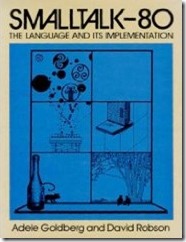The Smalltalk Programming Language
 The product of a team led by Alan Kay, Smalltalk is presented as an object-oriented, dynamically typed language. After several versions published during the 1970s, in 1980 the first widely distributed version (Smalltalk-80) was published, which formed the basis of the ANSI standard ratified in 1998.
The product of a team led by Alan Kay, Smalltalk is presented as an object-oriented, dynamically typed language. After several versions published during the 1970s, in 1980 the first widely distributed version (Smalltalk-80) was published, which formed the basis of the ANSI standard ratified in 1998.
Smalltalk arises in the context of the ARPA program, a project financed during the 1960s and from which other results and technologies emerge (such as hypertext, GUIs, multimedia or the Internet) that define what we understand today as computing. In particular, the characteristics of the language, the debugging tools and the development environment, influenced the development of modern GUIs and WYSISYG (What You See Is What You Get) environments.
Unlike other object-oriented languages, Smalltalk considers all the elements involved in the code as objects, without differentiating between objects and “primitive types” such as C++ or Java. Smalltalk syntax is minimalist and considers only six reserved words, the execution of operations being related to sending messages. Another feature of Smalltalk is the ability of a program to access and modify its structure, that is, the ability of a program to modify itself.
Although it was not the only language that reflects the object-oriented programming approach originally presented by Simula, Smalltalk-80 is the most successful language and therefore popularizes this programming paradigm. Virtually all later languages that support object orientation (Java, Python, Objective-C, etc.) have been influenced by Smalltalk.
Due to the importance of languages influenced by Smalltalk, it is currently not widely used and does not appear among the 50 most popular languages of the TIOBE ranking (2021).
Smalltalk
Born:1960
Evolution: Smalltalk-71; Smalltalk-72; Smalltalk-76; Smalltalk-80; ANSI Smalltalk (1998)
Influences of: Simula; Lisp; Logo
Influences: Objective-C; Java; Python; Scratch

